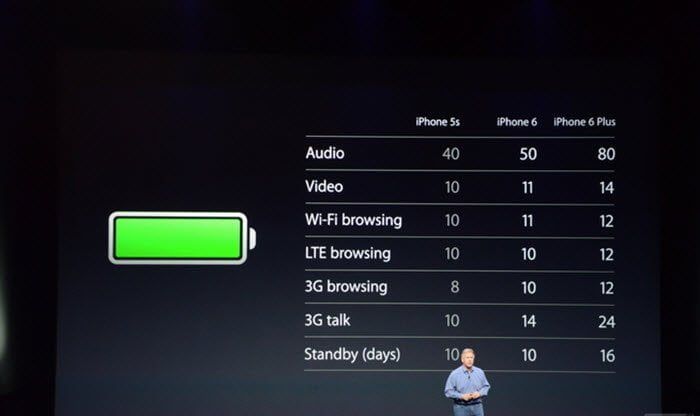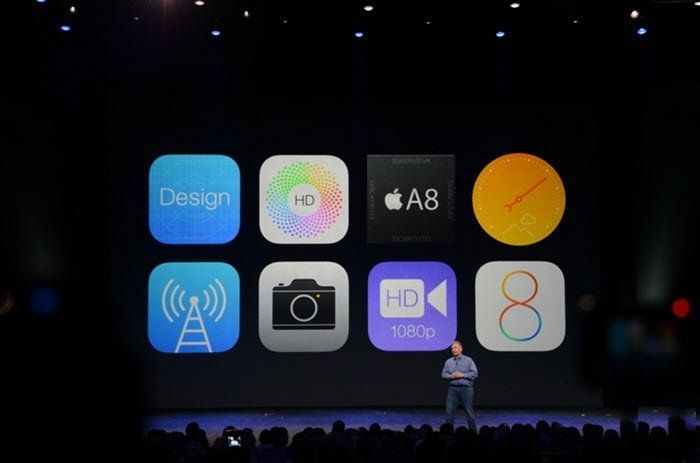
Apple has today announced the two long rumored iPhones. From the start, Apple planned on two different display sizes. It’s sRGB LCD active display with “Ion-strengthened glass,” the iphone 6 has a 4.7″ with 1334 x 750 resolution , and iphone 6 plus with 5.5″ at 11920 x 1080 resolution. The 6 Plus has 185% more pixels than the 5S. The 6 is 6.8mm thin, the 6 Plus is 7.1mm. That’s compared to 7.6 on the 5S. These are THIN phones. The display has a “broader” angle of view. Apple keeps making the phones thinner instead of keeping them the same and increasing battery size.
Reachability
The 6 Plus has a different UI already — it shows faces on the Messaging app.On the 6 Plus, you can go horizontal to get a 2 pane display. It’s basically like the iPad Mini Mini, when you use it in landscape. The homescreen can work horizontally too. Heck, even the keyboard has a bunch of new buttons in landscape. New keyboard keys for cut copy and paste on the 6 Plus. Indeed the side-swipe back gesture in iOS 7 was introduced in anticipation of these phones. You can just swipe to go back.
There’s a new gesture for the iPhone 6 and 6 Plus called “reachability.” You double-touch the home button and the whole display just slides down, so you can reach the top buttons.The power button is on the side now, so it’s easier to reach.
Apps scaling
There are 1.3 million apps available. Apps that aren’t updated for the iPhone 6 will just work, looks like they scale up. It’s a “desktop-class scaler,” technology that Apple is using to make all apps work. Developers can, of course, customize their apps for the biggest screens.
Power Chip within

The iphone 6 uses the new 2nd generation chip: the Apple A8. It’s a 64-bit chip. It has 2 billion transistors, on a 20nm process. It’s 13% smaller than the A7. 20% faster CPU, 50% faster graphics. Apple has promised better “sustained performance” so that the device can run at full power without causing heat.
With such power inside the phone, Metal, the 3D app and game engine that Apple introduced last year was demoed using a Super Evil Megacorp game during the event and it run beautifully and smoothly. This sustained performance claim is pretty strong — no doubt we’ll see a ton of testing to see how well it works against battery life. It allows games to develop “closer to the metal,” with less software between them and the processor.
The phones will have equal or better battery life as shown below. The iPhone 6 Plus claims 24 hours of 3G talk time.The iPhone 6 claims 14 hours of 3G talk time.

The M8 “motion coprocessor” is also on board, of course. It’s designed for fitness apps. Apple’s battery estimates are typically solid, but it’s going to take a lot of testing to prove these numbers out. The new M8 can tell the difference between cycling and running, and it can also calculate distance and elevation. It does that with a barometer, which uses air pressure to measure relative elevation. Nike is going to update Nike+ to use the barometer for elevation.

Connectivity
The LTE is better now. There are 20 LTE bands yes including our band back home, which is insane. And it does “carrier aggregation” to maximize speed. It also supports VoLTE, which is Voice over LTE. It makes your calls sound better. “We’re working with a lot of carriers around the world, Apple said during the keynote. There is also Wi-Fi is 802.11ac, which is good and fast Wi-Fi. And there will be Wi-Fi calling for some networks.
Camera
The phones have an 8MP camera, true-tone flash with 1.5 micron pixels and f/2.2 aperture. The “next generation iSight sensor has something called “focus pixels.” They do “phase detection” autofocus, which amounts to autofocus that’s twice as fast as the last generation. Panoramas can be up to 43 megapixels now. Also face detection is faster, and blink / smile detection is better too. Apple’s lead over the camera companies just increases as they dedicate resources against image processing.

The iPhone 6 has “digital” image stabilization, but the 6 Plus has optical image stabilization (OIS). OIS, if you didn’t know, is what moves the lens around to adjust for hand shake and the like. It’s not a first for a smartphone, but it will be great to have it on an iPhone. OIS, if you didn’t know, moves the lens around to adjust for hand shake and the like. It’s not a first for a smartphone, but it will be great to have it on an iPhone. The cameras can do video at 1080p at 30 or 60fps. Slo-Mo can do 240fps (that’s a lot of frames per second). For video, the cameras also do “cinematic video stabilization,” which is what you expect it to be.
The front-facing camera is also updated and is “perfect for taking those killer selfies.” Also “burst selfies.” No word on whether bursting killers with selfies is a feature.


